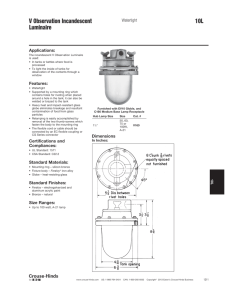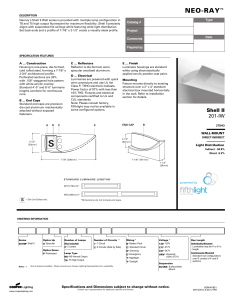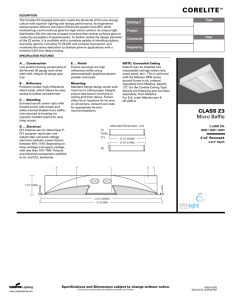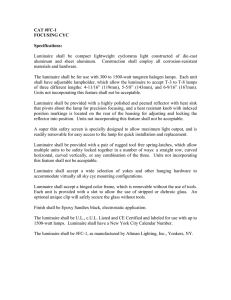Photometric Measurement of LED Luminaires
advertisement
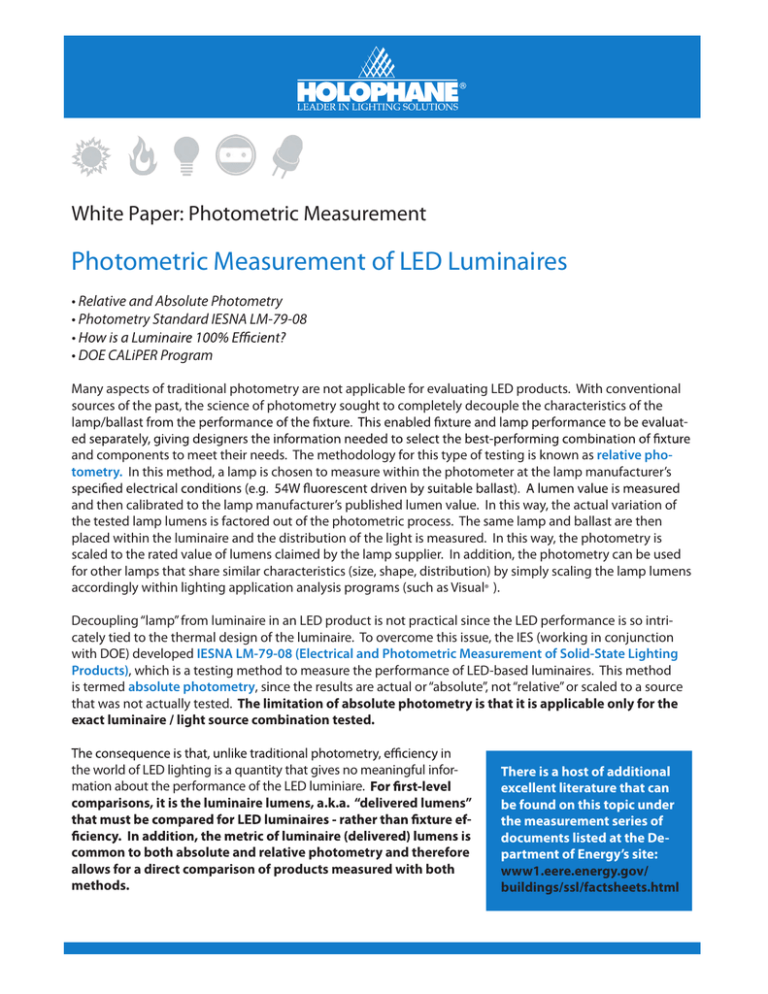
White Paper: Photometric Measurement Photometric Measurement of LED Luminaires • Relative and Absolute Photometry • Photometry Standard IESNA LM-79-08 • DOE CALiPER Program Many aspects of traditional photometry are not applicable for evaluating LED products. With conventional sources of the past, the science of photometry sought to completely decouple the characteristics of the - and components to meet their needs. The methodology for this type of testing is known as relative photometry. In this method, a lamp is chosen to measure within the photometer at the lamp manufacturer’s and then calibrated to the lamp manufacturer’s published lumen value. In this way, the actual variation of the tested lamp lumens is factored out of the photometric process. The same lamp and ballast are then placed within the luminaire and the distribution of the light is measured. In this way, the photometry is scaled to the rated value of lumens claimed by the lamp supplier. In addition, the photometry can be used for other lamps that share similar characteristics (size, shape, distribution) by simply scaling the lamp lumens accordingly within lighting application analysis programs (such as Visual® ). Decoupling “lamp” from luminaire in an LED product is not practical since the LED performance is so intricately tied to the thermal design of the luminaire. To overcome this issue, the IES (working in conjunction with DOE) developed IESNA LM-79-08 (Electrical and Photometric Measurement of Solid-State Lighting Products), which is a testing method to measure the performance of LED-based luminaires. This method is termed absolute photometry, since the results are actual or “absolute”, not “relative” or scaled to a source that was not actually tested. The limitation of absolute photometry is that it is applicable only for the exact luminaire / light source combination tested. the world of LED lighting is a quantity that gives no meaningful information about the performance of the LED luminiare. comparisons, it is the luminaire lumens, a.k.a. “delivered lumens” common to both absolute and relative photometry and therefore allows for a direct comparison of products measured with both methods. There is a host of additional excellent literature that can be found on this topic under the measurement series of documents listed at the Department of Energy’s site: www1.eere.energy.gov/ buildings/ssl/factsheets.html tribution and wattage of the tested luminaire. In some cases, additional information on the CCT and CRI of the the initial performance of the luminaire within a 25°C ambient environment. In ambients other than 25°C, an appropriate Luminaire Ambient Temperature (LAT) factor must be applied to account for the temperature response of the LED luminaire. This set of factors (LAT vs. temthe luminaire manufacturer. It is based on rigorous testing of the luminaire as well as information the luminaire manufacturer receives from their selected LED supplier. Additional background on LM-79-08: A word of caution is warranted here. With the emergence of this stanphotometric data reported is representative of a population of luminaires. With regard to the use of photometric data, LM-79-08 states “The data, however, should be used with the understanding that the photometric does not necessarily represent the average performance of a group of the same SSL luminiares.” As LED luminaires have become more integrated, optically and thermally, with the LED light source, it is now the responsibility of the luminaire manufacturer to ensure that their published performance data is indeed representative of the products they are manufacturing. In the past this was less of a concern as major manufacturers of conventional lamps maintained rigorous control of their product quality – and luminaire design had far less impact on lamp performance. To address this issue, the U.S. Department of Energy has established an LED product integrity program known as CALiPER1 to test products and audit manufacturer’s published performance data. Thus far the program has shown product integrity to be a valid concern as there have been numerous instances where manufacturers’ claims could not be validated by the CALiPER labs. is a ratio of the amount of light exiting the luminaire to the amount of light being produced by the lamps within. tially an inverse measure of the net absorption that takes indicates less absorption and is expressed as more lumens exiting the luminaire. With the absolute photometry method, as prescribed in LM-79-08, there is no measurement taken of the bare LED “lamp” since it cannot be removed from the luminaire withistics. This precludes the ability to ratio the light exiting the luminaire relative to the light produced only by the “lamp” – or in this case the LED module. Since the only quantity that luminiares is by default 100%. Relative Photometry Bare-Lamp Lumens =1000 Delivered Fixture Luminaire Lumens = 700 Absolute Photometry Bare-Lamp Lumens=(n/a) Delivered Fixture Luminaire Lumens = 700 1 CALiPER stands for Commercially Available LED Product Evaluation and Reporting. It is a program administered by the U.S. Department of Energy that supports testing of LED lighting products for noncommercial and educational use. For more information on the program, refer to: http://www1.eere.energy.gov/buildings/ssl/about_caliper.html.



